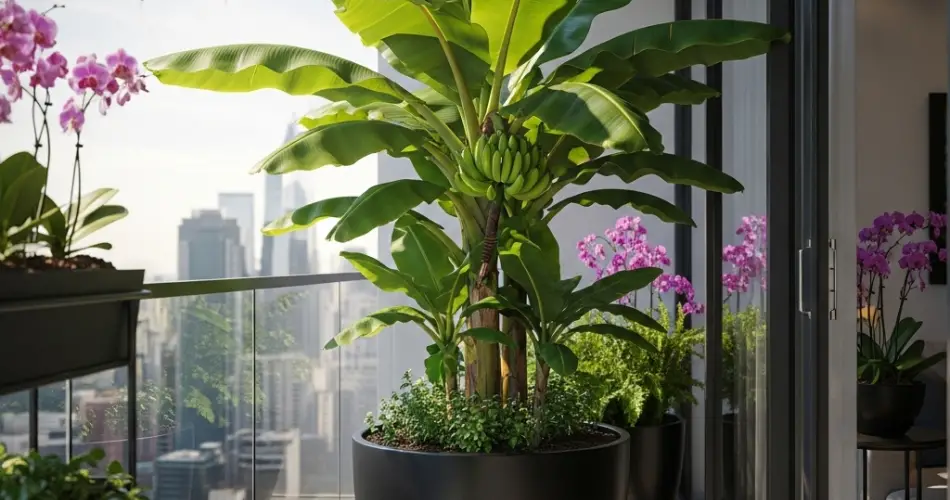Growing bananas on a balcony might sound ambitious, but it’s entirely possible with the right variety and care. These tropical plants can be cultivated in containers, making them suitable for urban gardeners or those with limited space. With sunlight, warmth, and proper maintenance, banana plants can thrive and even bear fruit in pots. Here’s a detailed guide to help you grow bananas successfully on your balcony.
Choosing the Right Banana Variety
Not all banana varieties are suitable for container growing. Dwarf and compact types are ideal because they don’t grow too tall and can adapt well to confined spaces. Some excellent varieties for pots include:
-
Dwarf Cavendish – Grows up to 6-8 feet, produces edible bananas.
-
Dwarf Red – An ornamental variety with reddish leaves and small fruit.
-
Super Dwarf Cavendish – Only grows 3-4 feet, great for very small balconies.
-
Dwarf Orinoco – Hardy and wind-resistant with large, delicious fruit.
When purchasing a plant, choose a healthy specimen with strong green leaves and a firm pseudostem.
Selecting the Right Container
Banana plants need large containers to support their fast-growing roots and stems. Use a pot that is at least 18–24 inches wide and deep, with good drainage holes. As the plant matures, you may need to repot it into a larger container. Use a heavy ceramic or plastic pot to prevent tipping as the plant grows taller.
Potting Mix and Drainage
A rich, well-draining potting mix is essential for healthy banana plants. Use a blend that retains moisture but doesn’t stay soggy. A good mix could include:
-
40% high-quality potting soil
-
30% compost or aged manure
-
20% perlite or coarse sand
-
10% coconut coir or peat moss for water retention
Make sure the pot has a layer of gravel or broken clay shards at the bottom to improve drainage.
Sunlight and Location
Banana plants love sunlight. Place your container in a sunny spot on your balcony that receives at least 6–8 hours of direct sun daily. If your balcony doesn’t get full sun, supplement with a grow light.
Banana plants are sensitive to cold, so if you live in a cooler climate, bring the pot indoors or to a sheltered spot when temperatures drop below 10°C (50°F). A sunny window indoors can help keep the plant growing during colder months.
Watering and Humidity
Bananas require consistent moisture. Water the plant deeply and regularly, keeping the soil moist but not waterlogged. During hot months, daily watering may be necessary. Reduce watering in winter when the plant’s growth slows.
Banana plants also love humidity. Mist the leaves regularly or place a tray of water with pebbles under the pot to increase moisture around the plant.
Fertilizing for Growth and Fruit
To support the plant’s vigorous growth, fertilize every 2–3 weeks during the growing season (spring and summer). Use a balanced liquid fertilizer (such as 10-10-10 or 20-20-20) or a slow-release fertilizer formulated for fruiting plants. Organic options like compost tea, banana peel extract, or fish emulsion also work well.
As the plant matures, increase feeding with a fertilizer high in potassium and phosphorus to encourage flowering and fruiting.
Pruning and Maintenance
Banana plants produce suckers (small shoots) from their base. Limit these to one or two so the main plant can focus its energy. Remove dead or damaged leaves to keep the plant tidy and promote air circulation.
Once a banana plant bears fruit, the mother plant will eventually die. At that point, cut it back and allow a healthy sucker to take its place. This cycle ensures continuous production.
Supporting the Plant
As the banana plant grows and starts to bear fruit, it may become top-heavy. Install a sturdy stake or plant support to keep the stem upright, especially in windy conditions or on a high-rise balcony.
Harvesting
Bananas typically take 9–15 months to fruit when grown in containers. The fruit is ready to harvest when it turns from deep green to a lighter green or yellow, depending on the variety. Cut the entire bunch with a sharp knife and allow it to ripen indoors.
Common Problems
-
Yellowing Leaves – Often a sign of overwatering or nutrient deficiency.
-
Brown Leaf Edges – Could indicate low humidity or salt build-up from fertilizer.
-
No Fruit – Insufficient sunlight, small pot size, or lack of nutrients may delay fruiting.
Final Thoughts
Growing bananas in containers on your balcony is a fun and rewarding experience. With the right variety, plenty of sun, regular feeding, and attentive care, you can enjoy lush foliage and even homegrown bananas in a small space. Whether you’re aiming for fruit or just the tropical aesthetic, banana plants are a bold addition to any balcony garden.
